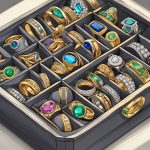Types Of Gems
Gems have been treasured for centuries for their beauty, rarity, and symbolism. From precious diamonds to semi-precious amethysts, there are countless types of gems found all over the world. Understanding the different types of gems, their properties, and uses can help you appreciate their value and choose the perfect gemstone for any occasion.
The classification of gems is based on a variety of factors, including their chemical composition, physical properties, and rarity. Precious gems, such as diamonds, rubies, and emeralds, are highly valued for their beauty, durability, and rarity. Semi-precious gems, such as amethysts, garnets, and topaz, are also popular for their unique colors and affordability.
Whether you are a gem collector, jewelry maker, or simply a lover of beautiful things, learning about the different types of gems can be a fascinating journey. From the symbolism and lore associated with each gemstone to the various cuts and shapes used in jewelry, there is always something new to discover about these precious treasures.
Key Takeaways
- Gems are classified based on their chemical composition, physical properties, and rarity.
- Precious and semi-precious gems are highly valued for their beauty, durability, and affordability.
- Learning about the different types of gems can be a fascinating journey, from their symbolism and lore to the various cuts and shapes used in jewelry.
Classification of Gems

Gemstones can be classified in various ways depending on their composition, hardness, rarity, and other factors. In this section, we will explore some of the most common methods of gemstone classification.
By Composition
Gemstones can be classified based on their composition. For example, minerals such as diamond, ruby, sapphire, and emerald are all considered gemstones. Organic materials such as amber, coral, and pearls are also considered gemstones.
By Hardness
Another way to classify gemstones is by their hardness. The Mohs scale is commonly used to measure the hardness of gemstones. This scale ranges from 1 to 10, with 1 being the softest and 10 being the hardest. For example, diamond is the hardest gemstone with a rating of 10, while talc is the softest with a rating of 1.
By Rarity
Gemstones can also be classified based on their rarity. Some gemstones are more common than others, and therefore less valuable. For example, amethyst and citrine are relatively common gemstones, while alexandrite and red beryl are extremely rare and valuable.
Overall, gemstone classification can provide important information about a gemstone’s properties and value. By understanding the different ways in which gemstones can be classified, one can better appreciate and evaluate these beautiful and valuable natural treasures.
Popular Gemstones and Their Properties
Diamond Characteristics
Diamonds are the most popular and valuable gemstones in the world. They are prized for their exceptional hardness, unmatched brilliance, and fire. Diamonds are formed from carbon and are the hardest natural substance known to man. They are graded based on the 4 Cs: cut, color, clarity, and carat weight.
The cut of a diamond determines how well it reflects light, while the color refers to the presence or absence of color in the diamond. Clarity refers to the presence of inclusions or blemishes in the diamond, and carat weight is a measure of the diamond’s weight. Diamonds are used in a variety of jewelry pieces, including engagement rings, earrings, and necklaces.
Colored Gem Varieties
There are many different types of colored gemstones that are popular in the jewelry industry. Some of the most popular include sapphires, emeralds, rubies, opals, aquamarines, tourmalines, corundum, beryl, quartz, garnet, amethyst, chalcedony, topaz, pearl, turquoise, spinel, and zircon.
Sapphires are known for their deep blue color, but they can also come in other colors such as pink, yellow, and green. Emeralds are prized for their vivid green color and are often used in high-end jewelry pieces. Rubies are known for their deep red color and are often used in engagement rings.
Opals are a unique gemstone that can display a variety of colors depending on the angle of light. Aquamarines are a light blue gemstone that is often used in necklaces and earrings. Tourmalines come in a variety of colors and are often used in unique jewelry designs.
Corundum is a mineral that is used to create both sapphires and rubies. Beryl is a mineral that is used to create emeralds and aquamarines. Quartz is a versatile gemstone that comes in a variety of colors and is often used in affordable jewelry pieces.
Garnets are known for their deep red color and are often used in vintage-style jewelry pieces. Amethysts are a popular purple gemstone that is often used in statement rings. Chalcedony is a gemstone that comes in a variety of colors and is often used in dainty jewelry pieces.
Topaz is a gemstone that comes in a variety of colors, including blue, pink, and yellow. Pearls are a unique gemstone that is formed inside of oysters. Turquoise is a blue-green gemstone that is often used in bohemian-style jewelry pieces. Spinel is a gemstone that comes in a variety of colors and is often used in affordable jewelry pieces. Zircon is a gemstone that comes in a variety of colors and is often used in vintage-style jewelry pieces.
Gemstone Cuts and Shapes
Gemstones are available in a variety of cuts and shapes, each with its own unique characteristics and beauty. The most popular cuts are faceted and cabochon cuts.
Faceted Cuts
Faceted cuts are the most common cuts used in gemstones. They are designed to maximize the stone’s brilliance and fire by reflecting light from the stone’s many facets. Faceted cuts are used for diamonds, sapphires, emeralds, and rubies.
Faceted cuts are designed to maximize the stone’s brilliance and fire by reflecting light from the stone’s many facets. The most popular faceted cut is the round brilliant cut, which has 58 facets and is used for diamonds. Other popular faceted cuts include the princess cut, oval cut, pear cut, and marquise cut.
Cabochon Cuts
Cabochon cuts are used for opaque or translucent gemstones such as pearls, opals, and turquoise. Instead of facets, cabochon cuts have a smooth, rounded surface that emphasizes the gemstone’s color and texture.
Cabochon cuts are available in a variety of shapes including oval, round, and teardrop. The most popular cabochon cut is the round cabochon cut, which is used for pearls.
When it comes to jewelry, gemstone cuts and shapes can greatly affect the overall look and feel of a piece. For example, a faceted diamond will sparkle and shine, while a cabochon pearl will have a smooth, lustrous surface.
In conclusion, understanding the different types of gemstone cuts and shapes can help you choose the perfect gemstone for your jewelry piece. Whether you prefer the brilliance of a faceted cut or the smooth texture of a cabochon cut, there is a gemstone cut and shape that will suit your style and taste.
Gemstones in Jewelry
Gemstones are a popular choice for jewelry due to their unique beauty and rarity. They can be found in a wide variety of colors, shapes, and sizes, making them versatile and suitable for different styles and occasions. When it comes to incorporating gemstones into jewelry, there are different setting types to choose from, each with its own advantages and disadvantages.
Setting Types
One of the most popular setting types for gemstones is the prong setting. This involves using metal prongs to hold the gemstone in place, allowing more light to enter and reflect off the stone. Prong settings are commonly used for diamonds, sapphires, emeralds, and rubies, as they showcase the gemstone’s brilliance and sparkle.
Another popular setting type is the bezel setting, which involves encasing the gemstone in a metal frame. This provides a secure hold for the gemstone and can protect it from damage. Bezel settings are commonly used for pearls, as they are delicate and require extra protection.
A third setting type is the channel setting, which involves placing gemstones in a metal channel between two walls. This provides a sleek and modern look, and is commonly used for diamonds and other small gemstones.
Care and Maintenance
Proper care and maintenance of gemstone jewelry is important to ensure its longevity and beauty. One important factor to consider is the type of metal used in the setting. Gold is a popular choice for its durability and resistance to tarnishing, but it can still scratch and dent over time. Regular cleaning and polishing can help maintain its shine.
Pearls, on the other hand, are organic gemstones that require special care. They should be stored separately from other jewelry and cleaned with a soft cloth and mild detergent. Avoid exposing them to chemicals, heat, and direct sunlight, as this can damage their luster.
Diamonds, sapphires, emeralds, and rubies are all hard gemstones that can withstand daily wear and tear. However, they should still be cleaned regularly to maintain their brilliance. A gentle cleaning solution and soft brush can be used to remove dirt and debris from the setting and gemstone.
In conclusion, gemstones are a beautiful and unique choice for jewelry, and there are different setting types and care requirements to consider when incorporating them into designs. By choosing the right setting type and practicing proper care and maintenance, gemstone jewelry can last for many years and be enjoyed for generations to come.
Symbolism and Lore
Gems have been valued and celebrated since ancient times, holding a significant place in many cultures and traditions. Their beauty and rarity have made them prized possessions, and their symbolism and lore have made them objects of fascination.
One of the most popular ways of assigning meaning to gemstones is through birthstones. These are gems that are associated with each month of the year and are said to bring luck and protection to those born in that month. For example, the birthstone for February is amethyst, which is said to promote calmness and clarity of mind.
Jade is another gemstone that has a rich history of symbolism and lore. In Chinese culture, it is believed to bring good luck, prosperity, and longevity. It is also associated with the heart chakra and is said to promote emotional balance and harmony.
Ruby, sapphire, emerald, and diamond are known as the “big four” in the world of gemstones. They are highly valued for their beauty, rarity, and durability. Ruby is associated with passion and love, sapphire with wisdom and truth, emerald with growth and renewal, and diamond with strength and purity.
Aquamarine and topaz are two gemstones that are known for their beautiful colors. Aquamarine is a pale blue-green gemstone that is associated with the ocean and is said to promote calmness and clarity of thought. Topaz, on the other hand, comes in a variety of colors, including yellow, pink, and blue. It is said to bring good fortune and protection to its wearer.
Gemstones can be colorless, have a fire-like appearance, be translucent, or be opaque. Some gemstones have unique patterns that make them even more valuable and prized. The value of a gemstone is determined by its rarity, beauty, and quality.
In conclusion, the symbolism and lore of gemstones have been passed down through generations and continue to fascinate people today. Whether they are used for their beauty or their supposed mystical properties, gemstones are truly treasures of the earth.






